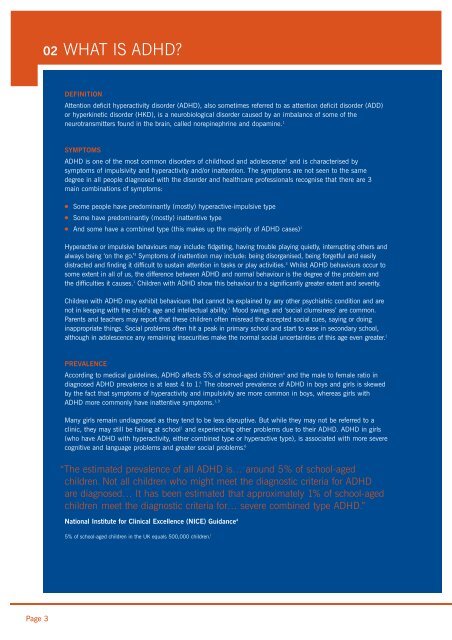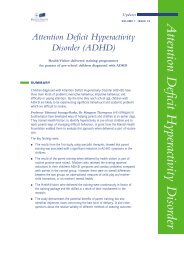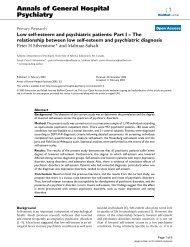are we paying enough attention? - Addiss
are we paying enough attention? - Addiss
are we paying enough attention? - Addiss
- No tags were found...
You also want an ePaper? Increase the reach of your titles
YUMPU automatically turns print PDFs into web optimized ePapers that Google loves.
02 WHAT IS ADHD?DEFINITIONAttention deficit hyperactivity disorder (ADHD), also sometimes referred to as <strong>attention</strong> deficit disorder (ADD)or hyperkinetic disorder (HKD), is a neurobiological disorder caused by an imbalance of some of theneurotransmitters found in the brain, called norepinephrine and dopamine. 1SYMPTOMSADHD is one of the most common disorders of childhood and adolescence 2 and is characterised bysymptoms of impulsivity and hyperactivity and/or in<strong>attention</strong>. The symptoms <strong>are</strong> not seen to the samedegree in all people diagnosed with the disorder and healthc<strong>are</strong> professionals recognise that there <strong>are</strong> 3main combinations of symptoms:●●Some people have predominantly (mostly) hyperactive-impulsive typeSome have predominantly (mostly) inattentive type● And some have a combined type (this makes up the majority of ADHD cases) 1Hyperactive or impulsive behaviours may include: fidgeting, having trouble playing quietly, interrupting others andalways being ‘on the go.’ 3 Symptoms of in<strong>attention</strong> may include: being disorganised, being forgetful and easilydistracted and finding it difficult to sustain <strong>attention</strong> in tasks or play activities. 3 Whilst ADHD behaviours occur tosome extent in all of us, the difference bet<strong>we</strong>en ADHD and normal behaviour is the degree of the problem andthe difficulties it causes. 1 Children with ADHD show this behaviour to a significantly greater extent and severity.Children with ADHD may exhibit behaviours that cannot be explained by any other psychiatric condition and <strong>are</strong>not in keeping with the child’s age and intellectual ability. 1 Mood swings and ‘social clumsiness’ <strong>are</strong> common.P<strong>are</strong>nts and teachers may report that these children often misread the accepted social cues, saying or doinginappropriate things. Social problems often hit a peak in primary school and start to ease in secondary school,although in adolescence any remaining insecurities make the normal social uncertainties of this age even greater. 1PREVALENCEAccording to medical guidelines, ADHD affects 5% of school-aged children 4 and the male to female ratio indiagnosed ADHD prevalence is at least 4 to 1. 5 The observed prevalence of ADHD in boys and girls is ske<strong>we</strong>dby the fact that symptoms of hyperactivity and impulsivity <strong>are</strong> more common in boys, whereas girls withADHD more commonly have inattentive symptoms. 1,3Many girls remain undiagnosed as they tend to be less disruptive. But while they may not be referred to aclinic, they may still be failing at school 1 and experiencing other problems due to their ADHD. ADHD in girls(who have ADHD with hyperactivity, either combined type or hyperactive type), is associated with more severecognitive and language problems and greater social problems. 6“The estimated prevalence of all ADHD is… around 5% of school-agedchildren. Not all children who might meet the diagnostic criteria for ADHD<strong>are</strong> diagnosed… It has been estimated that approximately 1% of school-agedchildren meet the diagnostic criteria for… severe combined type ADHD.”National Institute for Clinical Excellence (NICE) Guidance 45% of school-aged children in the UK equals 500,000 children. 7Page 3




